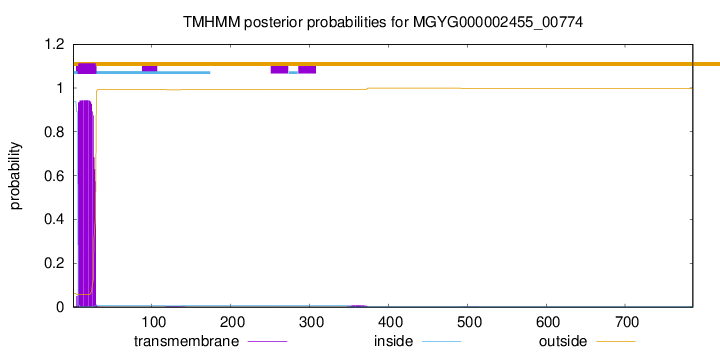You are browsing environment: HUMAN GUT
CAZyme Information: MGYG000002455_00774
You are here: Home > Sequence: MGYG000002455_00774
Basic Information |
Genomic context |
Full Sequence |
Enzyme annotations |
CAZy signature domains |
CDD domains |
CAZyme hits |
PDB hits |
Swiss-Prot hits |
SignalP and Lipop annotations |
TMHMM annotations
Basic Information help
| Species | Bacteroides cellulosilyticus | |||||||||||
|---|---|---|---|---|---|---|---|---|---|---|---|---|
| Lineage | Bacteria; Bacteroidota; Bacteroidia; Bacteroidales; Bacteroidaceae; Bacteroides; Bacteroides cellulosilyticus | |||||||||||
| CAZyme ID | MGYG000002455_00774 | |||||||||||
| CAZy Family | GH141 | |||||||||||
| CAZyme Description | hypothetical protein | |||||||||||
| CAZyme Property |
|
|||||||||||
| Genome Property |
|
|||||||||||
| Gene Location | Start: 31569; End: 33929 Strand: + | |||||||||||
CAZyme Signature Domains help
| Family | Start | End | Evalue | family coverage |
|---|---|---|---|---|
| GH141 | 27 | 543 | 4e-59 | 0.9867172675521821 |
CDD Domains download full data without filtering help
| Cdd ID | Domain | E-Value | qStart | qEnd | sStart | sEnd | Domain Description |
|---|---|---|---|---|---|---|---|
| cd00987 | PDZ_serine_protease | 9.04e-12 | 695 | 784 | 2 | 90 | PDZ domain of trypsin-like serine proteases, such as DegP/HtrA, which are oligomeric proteins involved in heat-shock response, chaperone function, and apoptosis. May be responsible for substrate recognition and/or binding, as most PDZ domains bind C-terminal polypeptides, though binding to internal (non-C-terminal) polypeptides and even to lipids has been demonstrated. In this subfamily of protease-associated PDZ domains a C-terminal beta-strand forms the peptide-binding groove base, a circular permutation with respect to PDZ domains found in Eumetazoan signaling proteins. |
| pfam13180 | PDZ_2 | 1.86e-08 | 715 | 786 | 3 | 74 | PDZ domain. |
| cd00991 | PDZ_archaeal_metalloprotease | 9.09e-08 | 719 | 785 | 11 | 77 | PDZ domain of archaeal zinc metalloprotases, presumably membrane-associated or integral membrane proteases, which may be involved in signalling and regulatory mechanisms. May be responsible for substrate recognition and/or binding, as most PDZ domains bind C-terminal polypeptides, and binding to internal (non-C-terminal) polypeptides and even to lipids has been demonstrated. In this subfamily of protease-associated PDZ domains a C-terminal beta-strand forms the peptide-binding groove base, a circular permutation with respect to PDZ domains found in Eumetazoan signaling proteins. |
| COG0265 | DegQ | 1.36e-07 | 695 | 786 | 250 | 338 | Periplasmic serine protease, S1-C subfamily, contain C-terminal PDZ domain [Posttranslational modification, protein turnover, chaperones]. |
| smart00228 | PDZ | 2.15e-05 | 701 | 775 | 9 | 83 | Domain present in PSD-95, Dlg, and ZO-1/2. Also called DHR (Dlg homologous region) or GLGF (relatively well conserved tetrapeptide in these domains). Some PDZs have been shown to bind C-terminal polypeptides; others appear to bind internal (non-C-terminal) polypeptides. Different PDZs possess different binding specificities. |
CAZyme Hits help
| Hit ID | E-Value | Query Start | Query End | Hit Start | Hit End |
|---|---|---|---|---|---|
| AWW32784.1 | 2.52e-199 | 10 | 760 | 17 | 773 |
| BAU63437.1 | 1.73e-37 | 36 | 564 | 78 | 593 |
| QNN21980.1 | 4.38e-33 | 27 | 667 | 23 | 676 |
| QHT69676.1 | 1.07e-31 | 8 | 664 | 4 | 687 |
| AWV97657.1 | 6.22e-31 | 18 | 663 | 20 | 707 |
Swiss-Prot Hits help
SignalP and Lipop Annotations help
This protein is predicted as SP

| Other | SP_Sec_SPI | LIPO_Sec_SPII | TAT_Tat_SPI | TATLIP_Sec_SPII | PILIN_Sec_SPIII |
|---|---|---|---|---|---|
| 0.000266 | 0.999060 | 0.000175 | 0.000166 | 0.000153 | 0.000156 |

